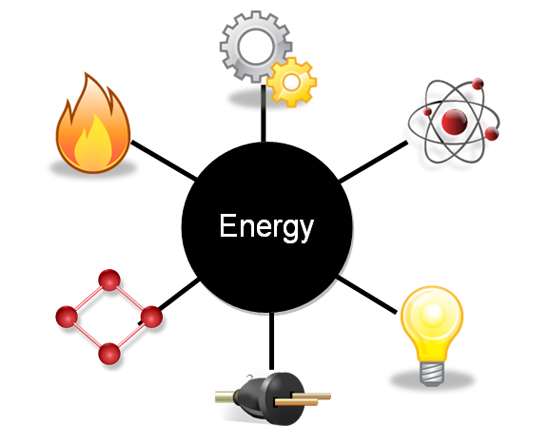
Mechanical energy - Energy associated with the motion or position of an object. Mechanical energy can occur as kinetic or potential energy. Every moving object has mechanical energy, whether it is a hammer driving a nail, a leaf falling from a tree, or a rocket flying in space. Machines use mechanical energy to do work. Our bodies also use mechanical energy to perform motions such as throwing a ball or moving a pencil to write on paper.
Thermal (heat) energy—All matter is made up of atoms and molecules. Due to their arrangement and motion, the particles have both potential and kinetic energy. Thermal energy is the energy of the movement of atoms and molecules in an object. When the particles move faster, the thermal energy increases. Temperature is really a measure of how much thermal energy is in an object. The higher the temperature, the faster the molecules are moving. In other words, the molecules have more energy.
Chemical energy - Chemical compounds, such as sugar, store chemical energy. Chemical energy is potential energy that is stored in chemical bonds. Chemical energy is stored in the foods you eat or in a match that is used to light a candle. Many energy sources commonly used by humans are forms of chemical energy.
Electrical energy - All matter is made up of atoms. Atoms consist of smaller particles: protons, which have a positive charge; neutrons, which have a neutral charge; and electrons, which have a negative charge. Electrons orbit around the center, or nucleus, of atoms. The nucleus is made up of neutrons and protons. Some materials, such as metals, have certain electrons that are only loosely attached to their atoms. They can easily move from one atom to another. When those electrons move among the atoms of matter, a current of electricity is created, and electrical energy is the energy they carry.
Radiant (light) energy - Electromagnetic energy, the light that you see each day, is a form of radiant energy. Radiant energy travels in waves. These waves have some magnetic properties and some electrical properties. Visible light, ultraviolet radiation, microwaves, and infrared radiation are all examples of electromagnetic energy.
Nuclear energy - Nuclear energy is a type of potential energy that is stored in the nucleus of atoms and is released during nuclear reactions, such as nuclear fission and fusion. Nuclear fission is when a nucleus splits, and fusion is when nuclei join together. Nuclear power plants use fission reactions to produce electricity. Nuclear fusion occurs in the sun and other stars.
